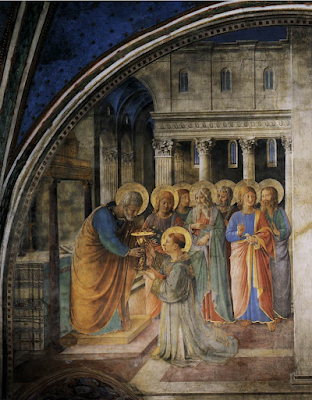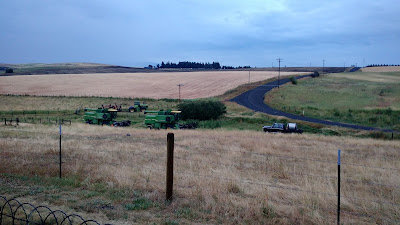A few more comments regarding evolution and the human ancestral tree:
 |
| Holotype being used for Homo bodoensis |
Earlier this month (November 2021), Natural History Museum (U.K.) published another hypothesized "direct" ancient hominoid ancestor by certain paleo-anthropologists 50 years after the find. Another new human species
This new species, foisted out of "necessity" so we are told, is to be called Homo bodoensis.
 |
| Homo bodoensis Image by Ettore Mazza |
This "scientific graffiti" has long defied logic anyhow. Obviously, every newly named species cannot possibly be "the" one direct human ancestral link. So belatedly, "splitters" may finally be coming around to the more generalist views of "lumpers".
What is being academically motioned is to use Homo bodoensis to describe most Middle Pleistocene humans from Africa and part of south-east Europe. Those from continental Europe are to be reclassified as Neanderthals. Regardless, this proposed species is added to a burgeoning (and often contradictory) pantheon of hominoids.
Proponents say it "is necessary to provide
clarity to this period." Clarity? Uh, not so much. Several scientific peers reviewing this proposal are uncertain that it clarifies anything. What paleo-anthropologists refer to as the "muddle in the middle" remains. (Middle Pleistocene is a geologic age. It too has been renamed. Apparently it is now supposed to be referred to as Chibanian, and thus avoid hemispheric chauvinism.)
For my part, I have the temerity to remind readers that my reluctance to adopt such newly declared "direct" species is not the result of brutish ignorance or intractable creationism. If I must endure inevitable sniffs from "scientific" elitists, fine. Call it being jaded if you must. But "scientists" themselves were the ones responsible for concocting this bushy tree maize of impossible contortions. They now pretend to "clean up". Heretofore, these scientists seemed fixed upon the prize of gaining public acclaim...in a quest to have their particular species proposal universally adopted as the new pretender for the "main stem" of current humans.
Previously stipulated in an earlier post, our "main stem" species already exists. It is widely known. Namely, Homo erectus, our indisputable ancestor. H. erectus used fire, collectively hunted, gathered and even navigated upon the open seas! Little wonder our actual direct human ancestor spanned Earth at least as late as 1.75 million years ago. Importantly, H. erectus remained in existence (was contemporary to a number of the so-called "direct" human species--including Homo sapiens, which scientists now say they wish to clean up).
We do not begrudge them their belated efforts. But if the math is correct, H. erectus predates their newly claimed "direct" ancestor, H. bodoensis, by easily over a million years. Just as easily, H. erectus was contemporary and outlived it on the timeline. If one assumes Homo erectus was present in time as far back as 2.1 million years ago, little if any real "muddle" exists. It's quite simple. Again, H. erectus sailed upon the seas well before the existence of this newly proposed H. bodoensis. Sailed the seas!...how much more direct and singularly human lineage is required? Homo erectus is our line.
 |
| Ernst Mayr (1904-2005) |
"All interpretations made by a scientist are hypotheses, and all hypotheses are tentative," Mayr noted. "They must forever be tested and they must be revised if found to be unsatisfactory." Okay. That is the theory, at least, of scientific discovery. Unfortunately, too many cut and paste science, thus cloning errors. Little wonder the human ancestral shrubbery, which has resulted from decades of paleo-anthropologists, needs cleaning up.
Mayr's view [Darwin and the Evolutionary Theory in Biology (1959)] is profound. The division he draws, in the vernacular, is between "lumpers" and "splitters". "The ultimate conclusions of the population thinker and of the typologist
are precisely the opposite," Mayr said.
"For the typologist, the type (eidos) is real and the variation an illusion, while for the populationist the type (average) is an abstraction and only the variation is real. No two ways of looking at nature could be more different." Aye!
Splitters will ever divide; ever invent new species, most of which are based only on the slimmest of so-called evidence. If those who seek to "clean up" the ancestral tree are successful today, doubtless they will find an equal number of grafts--illusions--after only a few decades in the future. Name seeking and acclaim will be no less then than they are now. Besides, none of this changes the central fact. Homo erectus is the ancestral species line of modern humans. H. erectus walked Earth for nearly two million years. Assuming variation is the illusion, H. erectus continues to walk this Earth through its progeny, our redundantly (albeit arrogantly) named species Homo sapiens sapiens. This is already clear. So, if an argument is to be made here, it would be to lump even further and rename our currently hubris named species as a subspecies, to wit: Homo erectus sapiens. But, arrogance is a curious commodity.
A great distance from science perhaps, but William Wordsworth's poetry (1770-1850 AD) is applicable to the vested interests of scientists, should the elitists ever wish to clean up their purportedly noble motives:
Getting and spending, we lay waste our powers;
Little we see in Nature that is ours;
We have given our hearts away, a sordid boon!
--Great God! I'd rather be
A pagan suckled in a creed outworn;
So might I, standing on this pleasant lea,
Have glimpses that would make me less forlorn





































